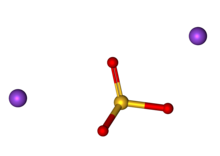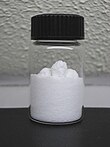Sodium sulfite
 | |||
 | |||
| |||
| Names | |||
|---|---|---|---|
IUPAC name Sodium sulfite | |||
| Other names Hypo clear (photography) E221 | |||
| Identifiers | |||
CAS Number |
| ||
3D model (JSmol) |
| ||
ChEBI |
| ||
ChemSpider |
| ||
ECHA InfoCard | 100.028.929 | ||
EC Number | 231-821-4 | ||
E number | E221 (preservatives) | ||
PubChem CID |
| ||
RTECS number | WE2150000 | ||
UNII |
| ||
InChI
| |||
SMILES
| |||
| Properties | |||
Chemical formula | Na2SO3 | ||
Molar mass | 126.043 g/mol | ||
| Appearance | White solid | ||
Odor | Odorless | ||
Density | 2.633 g/cm3 (anhydrous) 1.561 g/cm3 (heptahydrate) | ||
Melting point | 33.4 °C (92.1 °F; 306.5 K) (dehydration of heptahydrate) 500 °C (anhydrous) | ||
Boiling point | Decomposes | ||
Solubility in water | 27.0 g/100 mL water (20 °C) | ||
Solubility | Soluble in glycerol Insoluble in ammonia, chlorine | ||
log P | −4 | ||
Acidity (pKa) | ~9 (heptahydrate) | ||
Refractive index (nD) | 1.565 | ||
| Structure | |||
Crystal structure | Hexagonal (anhydrous) Monoclinic (heptahydrate) | ||
| Hazards | |||
Safety data sheet | ICSC 1200 | ||
NFPA 704 |  0 2 0 | ||
Flash point | Non-flammable | ||
| Related compounds | |||
Other anions | Sodium selenite | ||
Other cations | Potassium sulfite | ||
Related compounds | Sodium bisulfite Sodium metabisulfite Sodium sulfate | ||
Except where otherwise noted, data are given for materials in their standard state (at 25 °C [77 °F], 100 kPa). | |||
Infobox references | |||
Sodium sulfite (sodium sulphite) is a soluble sodium salt of sulfurous acid (sulfite) with the chemical formula Na2SO3. It is also used as a preservative to prevent dried fruit from discoloring, and for preserving meats, and is used in the same way as sodium thiosulfate to convert elemental halogens to their respective hydrohalic acids, in photography and for reducing chlorine levels in pools. In boiler systems, sulfite and bisulfite are the most commonly employed oxygen scavengers used to prevent pitting corrosion. Sodium sulfite is also a byproduct of sulfur dioxide scrubbing, a part of the flue-gas desulfurization process.
Contents
1 Preparation
2 Applications
3 Reactions
4 Descriptive chemistry
5 References
Preparation
Sodium sulfite can be prepared in lab by reacting sodium hydroxide solution with sulfur dioxide gas:
- 2 NaOH + SO2 → Na2SO3 + H2O
Evolution of SO2 by adding few drops of concentrated hydrochloric acid will indicate if sodium hydroxide is nearly gone, turned to aqueous sodium sulfite:
- Na2SO3 + 2 HCl → 2 NaCl + SO2 + H2O
Sodium sulfite is made industrially by reacting sulfur dioxide with a solution of sodium carbonate. The initial combination generates sodium bisulfite (NaHSO3), which is converted to the sulfite by reaction with sodium hydroxide or sodium carbonate.[1]
The overall reaction is:
- SO2 + Na2CO3 → Na2SO3 + CO2
Applications
Sodium sulfite is primarily used in the pulp and paper industry. It is used in water treatment as an oxygen scavenger agent, to treat water being fed to steam boilers to avoid corrosion problems,[2] in the photographic industry to protect developer solutions from oxidation and (as hypo clear solution) to wash fixer (sodium thiosulfate) from film and photo-paper emulsions, in the textile industry as a bleaching, desulfurizing and dechlorinating agent and in the leather trade for the sulphonation of tanning extracts. It is used in the purification of TNT for military use. It is used in chemical manufacturing as a sulfonation and sulfomethylation agent. It is used in the production of sodium thiosulfate. It is used in other applications, including froth flotation of ores, oil recovery, food preservatives, and making dyes.
Reactions
Sodium sulfite forms a bisulfite adduct with aldehydes, and with ketones forms a sulfonic acid. It is used to purify or isolate aldehydes and ketones.
Descriptive chemistry
Sodium sulfite is decomposed by even weak acids, giving up sulfur dioxide gas.
- Na2SO3 + 2 H+ → 2 Na+ + H2O + SO2
A saturated aqueous solution has pH of ~9. Solutions exposed to air are eventually oxidized to sodium sulfate. If sodium sulfite is allowed to crystallize from aqueous solution at room temperature or below, it does so as a heptahydrate. The heptahydrate crystals effloresce in warm dry air. Heptahydrate crystals also oxidize in air to form the sulfate. The anhydrous form is much more stable against oxidation by air.[3]
References
^ Weil, Edward D.; Sandler, Stanley R. (1999). "Sulfur Compounds". In Kroschwitz, Jacqueline I. Kirk-Othmer Concise Encylclopedia of Chemical Technology (4th ed.). New York: John Wiley & Sons, Inc. p. 1937. ISBN 978-0471419617..mw-parser-output cite.citation{font-style:inherit}.mw-parser-output .citation q{quotes:"""""""'""'"}.mw-parser-output .citation .cs1-lock-free a{background:url("//upload.wikimedia.org/wikipedia/commons/thumb/6/65/Lock-green.svg/9px-Lock-green.svg.png")no-repeat;background-position:right .1em center}.mw-parser-output .citation .cs1-lock-limited a,.mw-parser-output .citation .cs1-lock-registration a{background:url("//upload.wikimedia.org/wikipedia/commons/thumb/d/d6/Lock-gray-alt-2.svg/9px-Lock-gray-alt-2.svg.png")no-repeat;background-position:right .1em center}.mw-parser-output .citation .cs1-lock-subscription a{background:url("//upload.wikimedia.org/wikipedia/commons/thumb/a/aa/Lock-red-alt-2.svg/9px-Lock-red-alt-2.svg.png")no-repeat;background-position:right .1em center}.mw-parser-output .cs1-subscription,.mw-parser-output .cs1-registration{color:#555}.mw-parser-output .cs1-subscription span,.mw-parser-output .cs1-registration span{border-bottom:1px dotted;cursor:help}.mw-parser-output .cs1-ws-icon a{background:url("//upload.wikimedia.org/wikipedia/commons/thumb/4/4c/Wikisource-logo.svg/12px-Wikisource-logo.svg.png")no-repeat;background-position:right .1em center}.mw-parser-output code.cs1-code{color:inherit;background:inherit;border:inherit;padding:inherit}.mw-parser-output .cs1-hidden-error{display:none;font-size:100%}.mw-parser-output .cs1-visible-error{font-size:100%}.mw-parser-output .cs1-maint{display:none;color:#33aa33;margin-left:0.3em}.mw-parser-output .cs1-subscription,.mw-parser-output .cs1-registration,.mw-parser-output .cs1-format{font-size:95%}.mw-parser-output .cs1-kern-left,.mw-parser-output .cs1-kern-wl-left{padding-left:0.2em}.mw-parser-output .cs1-kern-right,.mw-parser-output .cs1-kern-wl-right{padding-right:0.2em}
^ "Pre-boiler and Boiler Corrosion Control | GE Water".
^ Merck Index of Chemicals and Drugs, 9th ed. monograph 8451

